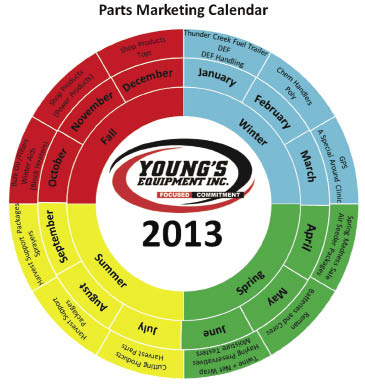Tim Young, General Manager, Young’s Equipment (2009 Dealership of the Year)
Marketing may be the most misused word in business today. Tim Young, general manager of Regina, Sask.-based Young’s Equipment, says it’s critical to have a specific understanding of marketing when business authors keep rewriting definitions to sell textbooks.
Young favors the following definition: “The process of planning and executing the conception, pricing, promotion and distribution of ideas, goods and services to create exchanges that satisfy individual and organizational objectives.”
Realizing what marketing entails is one thing, but being a “market-oriented” dealership is another. Dealers who are truly market-oriented, he says “continuously collect information about customer’s needs and competitor’s capabilities, share this information across departments and use it to create customer value.”

Working with parts managers, Young’s marketing specialist built an official parts marketing calendar that has brought good results. She also formalized a social media calendar and recruited staff members to post. The calendar also includes YouTube videos, as the dealership is now producing videos that help customers set up their own sprayer monitors, adjust combines, etc.
Information and its actual usage for decisionmaking he says, is where the rubber meets the road, “Just as we were talking earlier about data collection on equipment, there’s a tremendous amount of customer information in our business systems, our CRM systems, within our staff — and it doesn’t get shared properly. We all need to find ways to figure this out so we can continue to grow.”
Discussing the growth-option matrix on how growth is achieved with new products and existing customers and vice-versa, he says: “You need to take a look at where you are and decide which part of the matrix you’re in. There are so many markets there and this is why it’s important that the fastest learner wins. If you know where the trends are going, then you can be there first. If you’re second or third entering into a market, you’ll have real trouble.”
When determining your market segmentation strategy, Young advises dealers to consider market sensitivity, product variability, product life cycle, organizational size/resources, and the competition. “It’s a complex question. Our OEMs and a lot of our shortline companies try and help us, but it’s really important that you take a look at your own marketplace, decide what’s appropriate and your best way to influence it.”
But he cautions dealers from trying to be all things to all people, or following a “pick a market, any market” strategy. Young’s managers routinely hear the command of “make a decision.” He also said you can benefit by zigging one way when others are zagging.
One example was its decision with trade shows. “We boosted our investment in the November Agribition (traditionally a livestock-only show) event with a complete hockey rink full of farm equipment because that’s the time that our customers can come, when they aren’t under the pressure of seeding, spraying or harvest as when other shows are held. We don’t have a huge showroom, so we need to find a way to expose our customers to the products we’re trying to sell. There are many different ways to do that.”
Dealer Branding
“We are going to brand our company as much as the Case IH logo,” says Young. “We want people to take a look at us as a strong company, one that’s really forward looking.” The taglines of “Focused” and “Commitment” evolved out of a staff mission-vision process.
“They said ‘Focus and commitment is what we want customers to think about, and that nobody’s going to work longer hours, try harder or have more parts.’ That’s an important part of the way we go to market.”
That personal branding is also reinforced by Young and his son, Sean, who personally write and record all the radio commercials themselves. Customers start to identify with the voices and when they repeat the message back, with voice fluctuation, you know your message is resonating, says Young.
“When we first got into bulk oil business, our radio spots didn’t talk about our pricing or service, but instead focused on the 5-gallon pails laying about customers’ yards. We simply voiced a spot about recycling those oil pails and how it would SAVE YOU MONEY!” I can’t tell you how many customers came and said, ‘Tim, I’m here so you can SAVE ME MONEY!”
He adds that dealers must do something besides traditional print ads today; to differentiate themselves in a noisy market. As examples, he cited combine clinics for women and a various events involving 4H. “4H is where our future is going to come from,” he says. “Marketing is about being creative; finding new ways to engage your customers and have some fun with it.”





